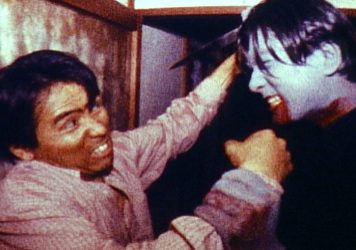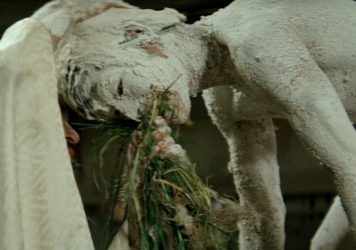
In the opening sequence of Blue Spring, with a Graduation Ceremony audible in the background, teenagers Kujo (Ryuhei Matsuda) and Aoki (Hirofumi Arai) pick a lock to the roof area of the single-sex Asashi High School, literally opening the door to their own future. From their newly unlocked vantage, the two childhood friends and a small gang of seniors can look down upon even their most aggressive fellow pupils, and gain a heightened perspective on their lives to come.
Writer/director Toshiaki Toyoda had already proven himself an astute chronicler of losers with his first two features, Pornostar and the documentary Unchain, and in this his third film, adapted from the 1993 episodic manga of Taiyō Matsumoto (‘Tekkonkinreet’, ‘Ping Pong’), he once again focuses on Japanese males struggling to find a place or purpose.
On the rooftop, these adolescents engage in a game of chicken, as pointless as it is potentially self-destructive: they hang over a ledge four storeys above the concrete ground and see who can clap the most times before regaining his purchase on the metal railing. It’s a game designed to determine who is the gang’s ‘boss’ – who is tough enough to set aside his fears and to take the greatest risk with his own life in order to prove an arbitrary superiority over the others. Kujo wins with eight claps but, ever aloof and diffident, immediately sees through the meaninglessness of both the exercise and his newly won status.
His response, a sort of ennui-laden insouciance, might be mistaken for cool, but in fact masks an introspective spirit that drives this naturally talented young man to question everything. ‘Gloomy freak’ and ‘total nerd’ Kujo is a lost soul, trying to work out where he is headed, and whether it is worth even bothering – and Blue Spring tracks his and his friends’ rites of passage at this key time of transition in their lives, teetering between youth and adulthood, life and death.
“What do you want, fucker? What do you want, you shit?” school tough guy Hori asks Kujo, facing off against Kujo the moment that he has been declared boss. “What the hell do you want?” This challenge will quickly earn Hori a broken nose, but his repeated question is key in a film about aimless, hopeless, clueless youth. Kimura (Yusuke Oshiba) has always wanted to get drafted for the baseball Nationals, but after misthrowing a ball, has fumbled his opportunity and his life’s dream, and is now looking for a new goal.
The gang’s gofer, freshman Yoshimura (Shugo Oshinari), just dreams of becoming a full member of the crew, while following in Kimura’s shadow. Meanwhile Yukio (Sousuke Takaoka), who constantly practises ‘Beautiful Dreamer’ on his guitar, risks having to repeat a school year because of his bad grades, and claims to have only ‘vague dreams’. Akio wants to rise above the shit (literally, in one hilariously corporeal scene) and to fly high, and to prove himself to Kujo.
Meanwhile the ailing loner known as Ghost (Eita) is prevented from having a future by a terminal disease, but is still always running not walking – when, that is, he is not painstakingly removing caterpillars from the school’s blossoming cherry trees, inspiring Kujo to observe: “People who know what they want scare me.” Kujo, of course, is full of doubts about his own future. Soon, however, Kujo is himself gardening too, planting and watering flowers under the watchful gaze of teacher Hanada (Mame Yamada).
This act of nurturing a living thing to full bloom, while observing the plants that are too dry to flower, is an obvious metaphor for the boys’ own, sometimes stunted processes of maturing. For all these young men are equally ridiculous, pathetic and beautiful in their rebellious quest for self-definition, even as, in one way or another, they all release their grip on childish things.
Absurd, melancholic and violent. But with the violence presented obliquely, and off-screen – unlike in the much more graphic Crows series which it has obviously influenced, and whose third instalment Toyoda himself directed in 2014 – the punkish Blue Spring shows male coming of age not just in all its competitive belligerence, but also in its boredom, its directionless and its disenchanted resignation. In the end, only some of the kids will be alright.
But Toyoda’s film perfectly captures youth’s fleeting yet hesitant springtime and sets it to a vibrant rock and blues score. Toyoda is still making films today (although they rarely if ever screen in the UK). So if you have never heard of him, and are looking for your new favourite contemporary Japanese director, catch Toyoda in early bloom with Blue Spring.
Blue Spring is released by Third Window in a Dual-Format Blu-ray/DVD edition on 13 May. Toshiaki Toyoda: The Early Years (Pornostar, Unchain, 9 Souls) is available in a limited edition Blu-ray set via Third Window.
Published 13 May 2019

By Anton Bitel
Shinichi Fukazawa’s Super-8 gem Bloody Muscle Body Builder in Hell is a throwback to ’80s horror.

By Mark Asch
A kaleidoscopic and intentionally lurid gangster rap battle movie from Japanese provocateur Sion Sono.

By Anton Bitel
Teruo Ishii’s Horrors of Malformed Men contains one of cinema’s most straightforwardly stark raving villains.